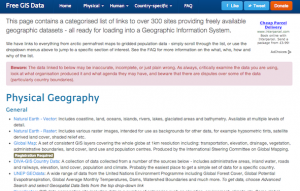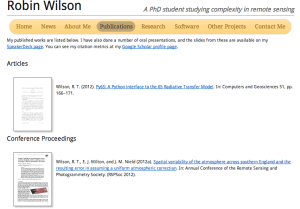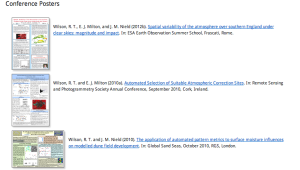The benefits of an academic website
Over the last few months I’ve helped a number of people setup academic websites, and various other people have asked me whether it’s worth a PhD student, Early Career Researcher or other academic creating a website, especially given that it does take a bit of time to do it well. My unequivocal answer is YES!
In emails to these people I’ve given a brief rundown of what websites I have created, what content they have, and – most importantly – what ‘good things’ have resulted from having these websites. Again, using one of Matt Might’s tips for academic blogging, I thought I’d ‘Reply to Public’ by just posting it as a blog post and pointing people here. So, here goes…
Summary: My various websites have been very useful to me. They get my name out there, and have got me paid work (contracting for various people during my PhD), as well as a huge range of opportunities.
I run three main websites: my main academic website, my blog, and my FreeGISData site. First off, these aren’t wonderful, and there are a lot of things that can be improved (particularly the design), but it’s the principle which is important. So, let’s look at those in turn:
Academic website
This is my ‘academic homepage’ and the link that I put on my business card and give out to people in email signatures etc. It has the standard ‘About Me’ stuff talking about what field I work in, what my research is about, and provides links to my various other sites. One key part of the site is the individual pages for pieces of software that I’ve written, such as Py6S, AutoZotBib and RTWTools, providing brief explanations and links to download them. Again, these are the links that I give out to people who are interested in my software (note that they are simple links that make sense – for example, http://www.rtwilson.com/academic/py6s – it goes where it says on the tin!).
A key page for any academic’s website is the publications list, shown above. Mine uses a graphical approach, breaking up the boring line of text with thumbnails of the first pages of the articles, which works particularly well for my conference posters:
Importantly, each paper/poster is linked to a full PDF and – even more importantly – the page has metadata in it allowing the papers on the page to be automatically added to citation managers such as Zotero and Mendeley. This was actually harder to do than I thought it would be, so I wrote a Python module to do it all for you – bib2coins. It takes a list of publications formatted as a BibTeX file and converts them to the COinS metadata that the citation managers can understand. I’ve now got a fully automated system that will allow me to add a new publication to my BibTeX file and will then automatically update my CV and the publications page and upload both to my website (hopefully I’ll get chance to blog how that works).
That reminds me of the other important item on an academic website: a full academic CV. You never know when someone might want to employ you – possibly as a temporary contractor – and the CV will help.
Blog
I post various short articles on my blog, in categories such as Academic, Computing, How To, My Software, Programming, and Reviews. There is a huge range of things on here – from instructions on how to fix network printer problems in Windows 7 (which are now referred to by Microsoft’s own support site) to reviews of academic and non-academic books, along with some more academic posts (such as information about my publications and the software I’ve released).
I don’t post on a regular schedule – I just post when I feel I have something interesting and useful to say. In fact, I have quite a few draft posts and ideas for posts that I haven’t found time to turn in to full posts yet. Overall it doesn’t take a huge amount of time, but quite a few people visit the blog and find it useful.
Free GIS Data site
This is my simplest site – it is just a long list of links – but my most popular.
 I started collecting a set of links to freely available GIS datasets (land cover, climate – all sorts of things) early in my PhD, and then decided that rather than just keeping the list on my computer, I’d put it on the web so that other people can use it. Other people really liked it, and I started to search for other datasets to add to the list. Loads of people have contacted me to suggest more datasets to add to the list – and there are now over 400 links there, in a huge range of categories.
I started collecting a set of links to freely available GIS datasets (land cover, climate – all sorts of things) early in my PhD, and then decided that rather than just keeping the list on my computer, I’d put it on the web so that other people can use it. Other people really liked it, and I started to search for other datasets to add to the list. Loads of people have contacted me to suggest more datasets to add to the list – and there are now over 400 links there, in a huge range of categories.
Visitor Statistics
Overall the websites get a fair number of visitors – not absolutely huge, but not too bad either. Approximate average and maximum monthly visits for each of the sites are listed below:
| Site | Average Monthly Visits |
Maximum Monthly Visits |
| Academic | 500 | 900 |
| Blog | 3,500 | 6,500 |
| Free GIS Data | 8,000 | 14,000 |
Results
This is the key bit: things that have happened because of my website. The general gist is that it has been really helpful, and has led to money, jobs, and free stuff – amongst other things. So, on with the list:
- Jobs: Directly through one of my blog posts, I’ve been contracted to do some processing of Landsat footprint shapefiles by some people in the US. The link to my website on my business card also helped me get some work with a university in London for a few weeks, which was very beneficial for me.
- Contacts: A huge range of people have contacted me because of my websites and blog posts – people at universities, in industry, the press, and larger organisations. I’ve had the UN contact me to ask whether it was ok to put my Free GIS Data list in a collection of useful sites to acquire data for disaster management (funnily enough, I said yes!), and I’ve been invited to do a keynote speech at a conference in Florida about the importance of freely available geographic data (although sadly this then fell through due to budget cuts at their organisation).
- Press: My work on John Snow’s cholera map was featured in the Guardian datablog purely because they found me on Google (my university press office later put out a press release), and this got featured on loads of other blogs, and I was interviewed on local radio.
- Free books: After reviewing a couple of books that I’d bought with my own money, I was contacted by a publisher and asked to review one of their books. This continued, and I have now reviewed books from three or four publishers – and one of these reviews was even published in a journal.
- Money: I have a ‘donate’ link on my Free GIS Data site. It doesn’t get much at all, but every so often someone donates a fiver. I also have a couple of (small) ads on my blog and my Free GIS Data site, run through the Google AdSense platform. So far I’ve made about £50 from these ads – not much, but enough to cover the hosting costs (or buy myself some nice treats!).
I’m sure there are many more good things that have happened (when my wife reads this she will probably remind me of some that I’ve forgotten) – but even just the ones above were well worth the cost of setting up the sites!
If you found this post useful, please consider buying me a coffee.
This post originally appeared on Robin's Blog.
Categorised as: Academic


Leave a Reply